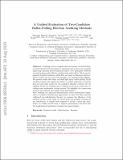| dc.contributor.author | Huang, Zhuoqun | |
| dc.contributor.author | Rivest, Ronald L | |
| dc.contributor.author | Stark, Philip B. | |
| dc.contributor.author | Teague, Vanessa J. | |
| dc.contributor.author | Vukcevic, Damjan | |
| dc.date.accessioned | 2021-02-22T22:59:54Z | |
| dc.date.available | 2021-02-22T22:59:54Z | |
| dc.date.issued | 2020-09 | |
| dc.identifier.isbn | 9783030603465 | |
| dc.identifier.isbn | 9783030603472 | |
| dc.identifier.issn | 0302-9743 | |
| dc.identifier.issn | 1611-3349 | |
| dc.identifier.uri | https://hdl.handle.net/1721.1/129969 | |
| dc.description.abstract | Counting votes is complex and error-prone. Several statistical methods have been developed to assess election accuracy by manually inspecting randomly selected physical ballots. Two ‘principled’ methods are risk-limiting audits (RLAs) and Bayesian audits (BAs). RLAs use frequentist statistical inference while BAs are based on Bayesian inference. Until recently, the two have been thought of as fundamentally different. We present results that unify and shed light upon ‘ballot-polling’ RLAs and BAs (which only require the ability to sample uniformly at random from all cast ballot cards) for two-candidate plurality contests, that are building blocks for auditing more complex social choice functions, including some preferential voting systems. We highlight the connections between the methods and explore their performance. First, building on a previous demonstration of the mathematical equivalence of classical and Bayesian approaches, we show that BAs, suitably calibrated, are risk-limiting. Second, we compare the efficiency of the methods across a wide range of contest sizes and margins, focusing on the distribution of sample sizes required to attain a given risk limit. Third, we outline several ways to improve performance and show how the mathematical equivalence explains the improvements. | en_US |
| dc.language.iso | en | |
| dc.publisher | Springer International Publishing | en_US |
| dc.relation.isversionof | http://dx.doi.org/10.1007/978-3-030-60347-2_8 | en_US |
| dc.rights | Creative Commons Attribution-Noncommercial-Share Alike | en_US |
| dc.rights.uri | http://creativecommons.org/licenses/by-nc-sa/4.0/ | en_US |
| dc.source | arXiv | en_US |
| dc.title | A Unified Evaluation of Two-Candidate Ballot-Polling Election Auditing Methods | en_US |
| dc.type | Book | en_US |
| dc.identifier.citation | Huang, Zhuoqun et al. "A Unified Evaluation of Two-Candidate Ballot-Polling Election Auditing Methods."
E-Vote-ID: International Joint Conference on Electronic Voting, Lecture Notes in Computer Science, 12455, Springer International Publishing, 2020, 112-128. © 2020 Springer Nature | en_US |
| dc.contributor.department | Massachusetts Institute of Technology. Computer Science and Artificial Intelligence Laboratory | en_US |
| dc.relation.journal | Lecture Notes in Computer Science | en_US |
| dc.eprint.version | Original manuscript | en_US |
| dc.type.uri | http://purl.org/eprint/type/ConferencePaper | en_US |
| eprint.status | http://purl.org/eprint/status/NonPeerReviewed | en_US |
| dc.date.updated | 2021-02-04T16:58:16Z | |
| dspace.orderedauthors | Huang, Z; Rivest, RL; Stark, PB; Teague, VJ; Vukcevic, D | en_US |
| dspace.date.submission | 2021-02-04T16:58:19Z | |
| mit.journal.volume | 12455 | en_US |
| mit.license | OPEN_ACCESS_POLICY | |
| mit.metadata.status | Complete | |
